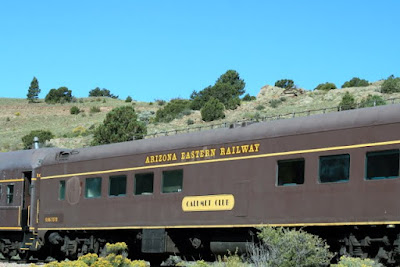

Lots of the people were doing sound recordings to accompany their photographs. Here is the largest microphone I saw.

And this fellow--who spent the morning photographing and recording the train and the afternoon working as relief engineer, driving the train--had a small recorder with a common sponge covering the microphone to filter wind noise.

Not all the photographers were riding on the train. Some were driving their cars on nearby roads, chasing the train from one photo stop to another. Look high on this hill and you will see four of these folks.

When you are using large, sophisticated cameras with long telephoto lenses, you need a tripod to get good pictures. That means a heavy load to schlep off the train and through the bushes at each stop.


John was one of those using just a small digital camera. But it also takes videos and made the one I included in my last blog.

Some of the photographers want to get shots from way up the hill above the tracks. It isn't easy to club up the hill with a camera and tripod.

However, sometimes a tripod makes a good hiking pole, easing the way down the same hill.

And here are some shots of the photographers in mass:


Often the photo line stretched a long way, making sure no one got into someone else's picture. They were there to take pictures of this beautiful engine with its vintage passenger cars, not the other photographers.

Sometimes we participate in an activity that has more elements involved than we expect. We had been on one previous rail fan photography trip, but I don't remember being very aware of the other photographers. This time I found them a major interest. It sure was a fun and interesting day.







































